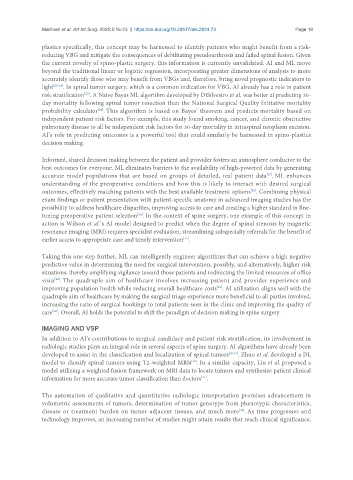Page 101 - Read Online
P. 101
Martinez et al. Art Int Surg. 2025;5:16-23 https://dx.doi.org/10.20517/ais.2024.73 Page 18
plastics specifically, this concept may be harnessed to identify patients who might benefit from a risk-
reducing VBG and mitigate the consequences of debilitating pseudoarthrosis and failed spinal fusion. Given
the current novelty of spino-plastic surgery, this information is currently unvalidated. AI and ML move
beyond the traditional linear or logistic regression, incorporating greater dimensions of analysis to more
accurately identify those who may benefit from VBGs and, therefore, bring novel prognostic indicators to
light [20-22] . In spinal tumor surgery, which is a common indication for VBG, AI already has a role in patient
risk stratification . A Naïve Bayes ML algorithm developed by DiSilvestro et al. was better at predicting 30-
[23]
day mortality following spinal tumor resection than the National Surgical Quality Initiative mortality
probability calculator . This algorithm is based on Bayes’ theorem and predicts mortality based on
[24]
independent patient risk factors. For example, this study found smoking, cancer, and chronic obstructive
pulmonary disease to all be independent risk factors for 30-day mortality in intraspinal neoplasm excision.
AI’s role in predicting outcomes is a powerful tool that could similarly be harnessed in spino-plastics
decision making.
Informed, shared decision making between the patient and provider fosters an atmosphere conducive to the
best outcomes for everyone. ML eliminates barriers to the availability of high-powered data by generating
accurate model populations that are based on groups of detailed, real patient data . ML enhances
[25]
understanding of the preoperative conditions and how this is likely to interact with desired surgical
[26]
outcomes, effectively matching patients with the best available treatment options . Combining physical
exam findings or patient presentation with patient-specific anatomy in advanced imaging studies has the
possibility to address healthcare disparities, improving access to care and creating a higher standard in fine-
tuning preoperative patient selection . In the context of spine surgery, one example of this concept in
[26]
action is Wilson et al.’s AI model designed to predict when the degree of spinal stenosis by magnetic
resonance imaging (MRI) requires specialist evaluation, streamlining subspecialty referrals for the benefit of
[27]
earlier access to appropriate care and timely intervention .
Taking this one step further, ML can intelligently engineer algorithms that can achieve a high negative
predictive value in determining the need for surgical intervention, possibly, and alternatively, higher risk
situations, thereby amplifying vigilance toward those patients and redirecting the limited resources of office
[28]
visits . The quadruple aim of healthcare involves increasing patient and provider experience and
improving population health while reducing overall healthcare costs . AI utilization aligns well with the
[29]
quadruple aim of healthcare by making the surgical triage experience more beneficial to all parties involved,
increasing the ratio of surgical bookings to total patients seen in the clinic and improving the quality of
care . Overall, AI holds the potential to shift the paradigm of decision making in spine surgery.
[28]
IMAGING AND VSP
In addition to AI’s contributions to surgical candidacy and patient risk stratification, its involvement in
radiologic studies plays an integral role in several aspects of spine surgery. AI algorithms have already been
developed to assist in the classification and localization of spinal tumors [30,31] . Zhuo et al. developed a DL
model to classify spinal tumors using T2-weighted MRIs . In a similar capacity, Liu et al. proposed a
[30]
model utilizing a weighted fusion framework on MRI data to locate tumors and synthesize patient clinical
[31]
information for more accurate tumor classification than doctors .
The automation of qualitative and quantitative radiologic interpretation promises advancement in
volumetric assessments of tumors, determination of tumor genotype from phenotypic characteristics,
disease or treatment burden on tumor-adjacent tissues, and much more . As time progresses and
[32]
technology improves, an increasing number of studies might attain results that reach clinical significance,

